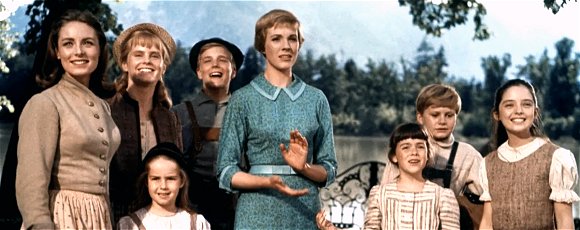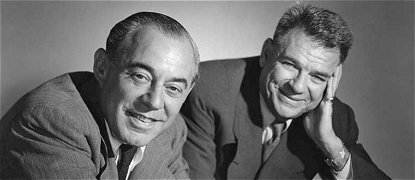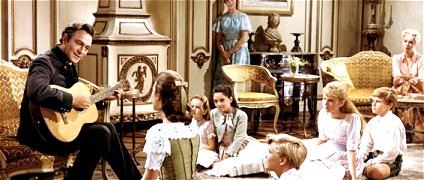Sixties
City presents
a wide-ranging series of
articles on all aspects of the Sixties, penned by the creator of the iconic
60s music paper Mersey
Beat
|
Sixties
City presents
a wide-ranging series of
articles on all aspects of the Sixties, penned by the creator of the iconic
60s music paper Mersey
Beat
|
|||||
|
| One
of the most successful screen musicals of all time, ‘The Sound of Music’
was released in 1965. The film’s squeaky-clean image – with Julie Andrews
in the leading role – seemed dated in the full flood of the new permissive
society. Yet it immediately became the biggest grossing film in cinema history
up to that time. ‘The Sound of Music’ was nominated in 10 categories of
the Academy Awards, winning five Oscars for: Best Film, Best Direction,
Best Editing, Best Sound and Best Music Score Adaptation. Julie Andrews
was also nominated as Best Actress, an award she’d received the previous
year for ‘Mary Poppins', but she lost out to Julie Christie in ‘Darling’.
By August 1966 ‘The Sound of Music’ had overtaken ‘Gone With the Wind’ as the all-time box office champion. By 1969 the film, which had cost $8 million, had earned more than $115 million and when it was reissued in 1971 it went on to break its own record. Die-hard fans devoted their lives to the tale of a governess who melts a widower’s heart while she teaches his musical children to sing. Thousands of people went to see it on several occasions, many as much as 30 times. One newspaper found a woman in Los Angeles who’d seen the film 300 times – but it was a woman in Cardiff, Wales, who found herself in the ‘Guinness Book of Records’ after seeing ‘The Sound of Music’ a staggering 930 times. The soundtrack album achieved a Gold Disc faster than any other in the history of the record industry and held the record for the longest stay at No.1 in the British charts – 69 weeks. It remained in the British charts for a total of 381 weeks and was in the American charts for 233 weeks, but the musical was not original to the cinema. ‘The Sound of Music’ had been the hit of the Broadway season in 1959 and was adapted from Maria Trapp’s autobiography ‘The Trapp Family Singers'. This was the true story of Maria, a novice nun who leaves the Nonnberg Abbey, an Austrian convent, to become the governess of the seven children of the proud, aristocratic widower, Baron Von Trapp. Although he’s engaged to a wealthy widow, Elsa Schraeder, the baron and Maria fall in love and marry. Their happiness is short-lived, as the Nazis invade Austria in 1938 and summon the captain to return to the navy. |

|
 |
The family
forms a singing group and use their cover as performers to escape over the
mountains into the neutrality of Switzerland. For the stage, the producers
had planned to use the folk songs the family sang when they performed. Co-producer
Leland Hayward asked legendary musical twosome Rodgers and Hammerstein to
supply some additional new songs. Rodgers informed Hayward that old songs should never be mixed with new. After considering the advice, Hayward told the pair that if they’d write an entirely new score, he’d postpone production until they were through working on their current project, ‘The Flower Drum Song’. At the time, both Dick Rodgers and Oscar Hammerstein had been plagued by serious illness. Dick had suffered fierce pain in his lower jaw - it was diagnosed as cancer and half of his jaw was removed. Ten days after the operation he was present at rehearsals for ‘The Sound of Music’. Oscar went into hospital for what he believed was an ulcer. It turned out to be incurable cancer. The play was having a try-out in Boston and a song was required for Captain Von Trapp. Oscar made his way there and he and Dick wrote ‘Edelweiss’ – their last composition together. Oscar died on August 23rd 1960. As a tribute, for the first and only time in the history of the theatre, all lights on Broadway and the West End were dimmed for three minutes silence. |
 |
| Although
Mary Martin had starred in the Broadway version, it was decided that the
film should have a youthful heroine and Julie Andrews was chosen. Marni
Nixon appeared as Sister Sophie and sang ‘Maria’ with Peggy Wood and the
Nun’s Quartet – Marni’s voice had been used in place of Audrey Hepburn’s
in ‘My Fair Lady’ and Natalie Wood’s in ‘West Side Story’. Christopher Plummer
appeared as Captain Von Trapp and Eleanor Parker as the baroness. The seven child actors who performed as the Trapp children were Charmian Cass as Liesl, Nicholas Hammond as Friedrich, Heather Menzies-Urich as Louisa, Duane Chase as Kurt, Angela Cartwright as Brigitta, Debbie Turner as Marta and Kyn Karath as Gretl. Ironically, the extraordinary success of the film encouraged 20th Century Fox to reunite the team of Julie Andrews and director Robert Wise in another lavish musical, ‘Star!’ but it proved a box office flop. A contrast between the Sixties and current times is indicated in the 2023 Chichester Festival Theatre production of ‘The Sound of Music’. Their ‘content guidance’ issued a warning that the musical included themes of “music; family; romance; the threat of Nazi Germany and the annexation of Austria. Some people might find the latter distressing”. We didn’t need trigger warnings in the Sixties, we just enjoyed the movies. |
 |
|
Article
Text
UK
web hosting by
|